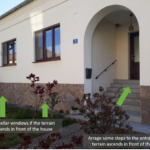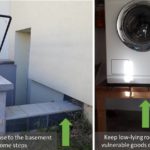Alat mjere smanjivanja rizika
SPRJEČAVANJE ŠTETE
«The benefits of prevention are not tangible; they are the disasters that did not happen.»
Kofi Annan, former UN SG
Što možete pronaći ovdje?

Ovo poglavlje pruža podršku, uglavnom općinama i privatnim osobama, kako bi saznali je li neko građevinsko zemljište ili objekt izloženo riziku plavljenja uslijed obilnih oborina, te ako jest, koje se mjere mogu poduzeti kako bi se izbjegao ili smanjio identificirani rizik. Osim toga, za postojeća naselja ili objekte koji su već izloženi riziku obilnih oborina pruža se podrška kroz davanje korisnih informacija i odgovarajućih zaštitnih mjera. Nadalje, tijela regionalne uprave mogu dati dodatnu podršku općinama i privatnim osobama, npr. kroz pružanje općih informacija.
Što je sprječavanje i na koji način može doprinijeti smanjenju rizika?
Mjere sprječavanja kod upravljanja rizikom od poplava su sve one mjere koje se mogu poduzeti u razdobljima bez obilnih oborina kako bi se izbjegao ili smanjio rizik od mogućih šteta ili gubitaka.
Fokus ovog poglavlja je na općinama i na privatnim osobama, budući da su upravo te dvije skupine dionika one s vjerojatno najvećim potencijalom za smanjenje štetnih posljedica zaštitom života, imovine i okoliša.
Što se može učiniti?
Pronađite osnovne korake i pribavite detaljnije informacije:
Privatne osobe mogu učiniti puno toga radi zaštite sebe i svoje imovine od oštećenja uslijed poplave zbog obilnih oborina. Kuće i druge građevine mogu se projektirati kako bi bile otporne na poplave, postojeće kuće izložene riziku od poplave mogu se obnoviti kako bi se smanjile buduće štete od poplava. Stanovnici mogu razviti privatni plan uzbunjivanja i osigurati financijsku sigurnost, npr. sklapanjem police osiguranja od poplava.
Za razvoj općine odgovorna su tijela javne općinske uprave. Oni su ključni akteri za prikupljanje dostupnih informacija o riziku od obilnih oborina, za popunjavanje informacijskih praznina, usmjeravanje stanogradnje sigurne od poplava i razvoj infrastrukture, za pokretanje komunalnih mjera za zaštitu od poplava, pokretanje izrade planova upravljanja u hitnim situacijama za plavljenje uslijed obilnih oborina i pružanje informacija za stanovništvo.
Regionalne uprave često su odgovorne za pružanje informacija o pitanjima više razine poput npr. poplava. S obzirom na prilično lokalnu problematiku obilnih oborina, neke uprave općinama i privatnim osobama osiguravaju pomoćne materijale poput informativnih brošura, tehničkih vodiča i informacija o financiranju, osiguravajući na taj način usklađeni proces informiranja i planiranja i smanjenja rizika u svojoj regiji.
...kao privatna osoba




1. korak: Budite upoznati s rizicima
Provjerite svoju lokaciju:
- Nalazi li se vaša nekretnina na području u obliku udoline ili pod nagibom a relevantni dijelovi zemljišta stoje iznad buduće kuće ili ostalih objekata?
- Leži li vaš planirani objekt u udolini ili je u blizini ulice pod nagibom?
- Postoje li vodotoci (koji su presušili) u blizini i kako se povećava njihov vodostaj tijekom ili nakon obilnih oborina?
- Postoji li u susjedstvu relevantan udio nepropusnog tla ili tla sa smanjenim kapacitetom infiltracije i hoće li buduće građenje pogoršati trenutnu situaciju?
- Može li voda iscuriti iz obližnjih kanalizacijskih sustava i preliti se na moj objekt/buduću kuću?
- Hoće li moja buduća kuća biti spojena na kanalizaciju?
- Mogu li obilne oborine uzrokovati probleme zbog preopterećenih sustava odvodnje s krovova, sustava odvodnje u dvorištima ili infiltracijskih sustava?
Svaki od ovih faktora može pridonijeti plavljenju zbog obilnih oborina.
Pitajte prethodne vlasnike zemljišta ili trenutne susjede:
- Je li prije bilo pojava poplava?
- Zadržavaju li se nakon kiše na vašem posjedu često ili u duljim razdobljima lokve, javljaju li se blatnjava područja ili erozija?
Ukoliko da, možda postoji problem s plavljenjem uslijed obilnih oborina.
Planirajte izgrađene objekte: općenito govoreći, dužni ste ne pogoršavati stanje s poplavama za svoje susjede. Stoga na svom posjedu trebate planirati izgrađene objekte (glavna kuća, pomoćne zgrade, pločnici, ograde) tako da (i) obilne oborine mogu slijediti prirodne puteve tečenja na površini, od gornjih ulaza protoka do vašeg posjeda prema donjim ispustima protoka na vašem posjedu, (ii) brzina protoka vode na vašem imanju ostaje kao i prije ili još bolje smanjuje se, (iii) količina kišnice koja se ispušta u donje ispuste ostaje kao i prije ili još bolje smanjuje se, npr. kroz nove infiltracijske mjere.
Pogledajte internetske portale: države članice EU izradile su službene karte opasnosti i rizika od poplava, uglavnom za riječne poplave, ali odnedavno i za poplave uslijed obilnih oborina. Ostale službene karte mogu se dobiti od saveznih portala za prirodne opasnosti ili od tijela zaduženih za upravljanje vodama. Ove se službene informacije mogu ocijeniti kao valjane i pouzdane. Pored toga, možda postoje i drugi proizvodi dostupni javnosti, koji možda dolaze iz akademskih ustanova, kooperacija ili tehničkih ureda. Te bi se informacije mogle ocijeniti kao indikativne. U niže navedenim kućicama nalazi se popis poveznica na dostupne informacije s interneta.
Pitajte svoju općinu: Ništa niste pronašli na internetu? Onda pitajte svoju općinu: oni možda imaju opće karte prirodnih opasnosti ili specifične karte poplava uslijed obilnih oborina ili druge planove koji se bave problemima plavljenja uslijed obilnih oborina poput npr. planova zona opasnosti. U svakom slučaju, u općini bi mogli znati gdje se takve informacije mogu dobiti.
Kako čitati i koristiti karte poplava: karte poplava obično prikazuju jednu ili više sljedećih informacija: područja opasnosti ili rizika, putovi protoka, poplavljena područja, dubina vode, brzina tečenja. Ako možete identificirati svoju nekretninu, tada možete procijeniti je li joj dodijeljen rizik obilne oborine ili ne. U nastavku možete pronaći pomoć projekta RAINMAN za čitanje karata opasnosti i rizika.
PROČITAJTE VIŠE
- Governmental indicative heavy rain hazard map for Austria
- National platform for natural hazard overview and risk assessment for Austria
- State Hydrographic Services Website for statistical and historical precipitation data, incl nowcasting services, based on station data
- Central Institution for Meteorology and Geodynamics Website for precipitation nowcasting and historical data, based on radar data
- Styrian GIS-Portal for waters and water information
- Styrian GIS-Portal for spatial information
- Regional flow path map from Lower Austria
- Case study Upper Austria: heavy rain hazard map
- Municipal flow path map of Graz (City of Graz)
- National map with heavy rain flow paths and critical points
- Official Hydrometeorological Institute portal with flood nowcasting, forecasting, and alert services
- Official Hydrometeorological Institute portal with natural hazards alert information
- Official Hydrometeorological Institute portal with actual precipitation radar data
- Official water management information portal a.o. with station precipitation data
- National topographical map with detailed digital relief model
- Fairytales for children on responsible handling of rainwater issues
In Germany information is sometimes offered on national level, but also frequently offered on the federal state level, and sometimes even on the municipal level. Therefore the link list below contains a selection of examples which are – from the RAINMAN perspective – considered as current good-practice.
If you want to know your risk, you might find information on federal state level regarding flood forecast information, early warning, topographical information, guidance for assessing and mapping of heavy rain risks. The heavy rain hazard and risk maps are often available on the municipal level.
- State German weather Service (DWD) website for precipitation data, statistics, now- and forecasting services
- Website by the insurance industry with risks maps for different natural hazards for parts of Germany
- Official Saxonian Flood Center Website with nowcasting and forecasting information and early warning
- Official Saxonian topographical maps
- Official Saxonian digital elevation model
- Case study Glems catchment area – heavy rain hazard maps with inter-municipal cooperation of eight municipalities in Baden-Wurttemberg
- City of Cologne Website with heavy rain hazard and risk maps
- Official Baden-Wurttemberg website with guidance on heavy rain risk assessment and mapping for municipalities, incl funding
- Official North-Rhine-Westphalia website with guidance on heavy rain risk assessment and mapping for municipalities
- City of Bremen website for climate adaptation strategies
- Polish meteorological service: portal for weather nowcast, forecast, radar maps, historical data
- Polish meteorological service: climate data
- Polish meteorological service: station data
- Institute of Meteorology and Water Management-National Research Institute (IMGW-PIB): official design precipitation values upon request
- Polish meteorological service: precipitation forecast for the next two hours for Poland
- Topographical map
Get some insights on how other countries, which were not involved in RAINMAN, are approaching heavy rain risk assessment and mapping:
Belgium:
- Combined map of pluvial and fluvial flood risk for Flanders
- Heavy rain hazard map for Flanders with flooded areas
- Official precipitation nowcast and forecast
The Netherlands:
- National heavy rain hazard map, with water depth for two different precipitation events (70mm in 2 hours and 140 mm in 2 hours)
- National now-casting precipitation service
- Online archive of precipitation data (GIS interface)
United Kingdom:




Alat PROCJENA i IZRADA KARATA pruža dodatne informacije o tome kako procijeniti i prikazati svoje opasnosti i rizike.




2. korak: Spriječite štetu
Privatne osobe mogu na učinkovit način zaštititi sebe i svoju imovinu od poplava uslijed obilnih oborina. Kuće i drugi objekti na posjedu mogu se graditi na mjestima ili biti projektirani na sljedeći način
- idealno da u objekt ne utječe obilna oborina,
- idealno da nikakva obilna oborina ne može ući u objekt, ili
- dijelovi objekta zahvaćeni poplavom koriste se na način da ulazak vode ne nanosi štetu.
Već postojeće kuće izložene mogućem riziku plavljenja uslijed obilnih oborina mogu se nadograditi kroz tehničke mjere kako bi se smanjile ili uklonile buduće štete, npr.
- mogu se postaviti barijere protiv poplava kako bi se spriječilo da voda uđe u objekt
- korištenje dijelova zgrade pogođenih poplavama može se promijeniti na način da ulazak vode u budućnosti neće izazvati štetu.
Također na posjedu se mogu uspostaviti prirodne mjere poput novih retencijskih područja ili mjera infiltracije u tlo kako bi se smanjio protok vode na površinu.
U konačnici, mogu se utvrditi mjere pripreme, npr. ukućani mogu izraditi privatni plan uzbunjivanja i osigurati financijsku sigurnost, npr. sklapanjem police osiguranja od poplave.
Na vašem području možda su dostupni stručnjaci poput osiguravajućih društava, arhitekta, projektanti/pravne osobe za sustave za zaštitu od poplava, općinske savjetodavne službe koje će vam pomoći u procjeni rizika i pronalaženju odgovarajućih mjera.
READ MORE
- Governmental manual on self protection measures for floods
- Official weather alerts from the Central Institute for Meteorology and Geodynamics
- Governmental alert system for emergency situations
- Upper Austrian civil protection information for heavy rain
- Official Styrian website on self protection measures for floods
- Official Styrian guidance for surface drainage in building approval proceedings
- Styrian agricultural Chamber portal providing information about erosion and water runoff reduction, incl. Consultation support
- Brochure from agricultural chamber of Upper Austria on good professional practice for water protection
- City of Graz portal with information for flood adapted planning and construction
- City of Graz Andritz and St. Peter brochure for for private action before, during and after floods
- City of Graz Brochure on self protection for floods
- Graz Holding portal with brochure “water in the cellar” on sewer system backflow prevention
- Brochures for water resistant planning and construction from Austrian Water and Waste Management Association
- Czech Hydrometeorological Institute website with reporting and flood forecasting service
- South Bohemian Region information materials for private protection against heavy rain floods
- Brochure with instructions for flood victims from Prague NGO
- Instructions for behaviour in torrential floods
- Czech project website on stormwater management for public authorities and technical planners
- Ministry of Environment Catalogue on natural based solutions for water retention in the landscape
- National website on standards for good agricultural and environmental soil conditions
- Water research institute webpage on erosion and rainwater flood mitigation through nature-based solutions
- Archive from Czech public forest management research institute with guidelines for water management in forest soils
- Czech fire brigade portal with seminar report on emergency management for municipalities
- Official weather alerts from Hungarian National Meteorological Service
- Guidance on blue and green infrastructure for rain water management in urban areas, for private properties and public space, from annex to Hungarian Danube river basin management plan
- Good forestry practice for farmers from national chamber of agriculture
- Good agricultural practice for farmers from national chamber of agriculture
In Germany information is sometimes offered on national level, but also frequently offered on the federal state level, and sometimes even on the municipal level. Therefore the link list below contains a selection of examples which are – from the RAINMAN perspective – considered as current good-practice.
If you want to prevent damages, natural hazard information is often found on federal state levels, the same applies to general guidelines for private protection or municipal measures. In some cases, city websites also contain heavy rain information for prevention.
- Official weather alerts app from German Weather Services
- Nationwide Hazard Warning app from Scientific Research Institute
- Governmental hazard warning App from Federal Office of Civil Protection and Disaster Assistance, with weather and flood alerts
- Saxonian competence center website for private flood protection
- Official Saxonian natural hazards information website for private persons
- Informative portal from the insurance industry on private risk prevention for heavy rain
- Guideline on private protection measures against heavy rain, from municipal water disposal organisation of City of Cologne
- Brochure for heavy rain preventive planning and construction, from City of Leipzig water management
- City of Hamburg water management website for green and blue infrastructure and decentralized rainwater management
- Bydgoszcz investment project for rainwater drainage and adaptation to climate change
- Bydgoszcz guidelines and solutions for green-blue infrastructure
- Wroclaw legal act for sustainable rainwater management
- City of Wroclaw good practice catalogue for sustainable management of stormwater from road surfaces
- City of Wroclaw price estimations for stormwater management solutions
- City of Wroclaw (2019): dotation program “Catch the rain” for increasing natural retention
- City of Wroclaw catalogue (part 2) for sustainable management of stormwater in an urbanized area
- Warsaw Case study for sustainable use of surface and rainwater, from Sustainability foundation
- City of Lodz case study for small retention program
- Lodz infrastructure Brochure for rainwater retention on property level
- Official Guidebook for erosion protection
- Official code of good agricultural practice
- Instructional brochures on increasing landscape retention from sustainability foundation
- Project guideline for erosion reduction measures in mountain regions
- Project guideline for runoff and erosion management in agricultural areas
Get some insights on how other countries, which were not involved in RAINMAN, are approaching prevention of damages from heavy rain:
Belgium:
- Official collection of self protection measures for private properties against floods
- Official self protection measures for private properties and an interactive test to determine the influence of new buildings on the water system
- Official information on flood prevention and protection
- Heavy rain self protection measures for private properties (insurance company, in be/en)
The Netherlands:
- Collection of measures to increase infiltration on private properties
- Awareness raising for self protection measures in case of flooding for general public
- Iniative to reduce paved surfaces in gardens and public areas
- Collection of agricultural measures to reduce erosion and increase infiltration
- Agricultural measures for climate adaptation in Brabant
United Kingdom:




Katalog alata RAINMAN pruža sveobuhvatan pregled mogućih mjera: pregledajte naš KATALOG 100 MJERA SMANJENJA RIZIKA
...kao općina




1. korak: Budite upoznati s rizicima
Meteorološka obilježja: Provjerite s hidrografskim službama u vašoj regiji obilježja oborina na dotičnom području. Ako je razina godišnjih oborina visoka, ako postoji velika vjerojatnost pojave obilnih oborina ili u prošlosti postoje iskustva s poplavama uslijed obilnih oborina, možda imate problem.
Obilježja lokacije:
Zapitajte se sljedeća pitanja:
- Je li vaše područje u obliku udoline ili pod nagibom a relevantni dijelovi stoje iznad budućeg gradilišta?
- Postoje li vodotoci (koji su presušili) u blizini i kako se povećava njihov vodostaj tijekom ili nakon obilnih oborina?
- Postoji li na tom području relevantan udio nepropusnog tla ili tla sa smanjenim kapacitetom infiltracije i hoće li buduće građenje pogoršati trenutnu situaciju na samom području ili u susjednim područjima?
Svaki od ovih faktora može pridonijeti plavljenju zbog obilnih oborina.
Pitajte stanovnike: pitajte trenutne vlasnike zemljišta ili trenutne susjede na tom području: Je li prije bilo pojava poplava? Zadržavaju li se nakon kiše često ili u duljim razdobljima lokve, javljaju li se blatnjava područja ili erozija? Ukoliko da, možda postoji problem s plavljenjem uslijed obilnih oborina.
Pribavite informacije: Zatražite od višeg tijela za prostorno planiranje (npr. regionalne uprave) regionalne prostorne planove ili regionalne planove razvoja koji uzimaju u obzir rizike od obilnih oborina. Raspitajte se kod vašeg višeg nadležnog tijela (npr. regionalna uprava) za upravljanje vodama za dostupne informacije o izradi karata opasnosti od obilnih oborina.
Kako koristiti te informacije: Instrumenti lokalnog planiranja trebaju uzeti u obzir informacije dostupne na regionalnoj razini tako da se buduća infrastruktura i objekti mogu postaviti i projektirati tako da su otporni na plavljenje uslijed obilnih oborina. Ako je moguće, službeni građevinski propisi dodatno mogu zahtijevati od budućih vlasnika kuća da se gradnja vrši na način otporan na poplave. Osim toga, lokalno planiranje treba projektirati tako da se već postojeći rizici za postojeću infrastrukturu i zgrade ne povećavaju.
Kako procijeniti/kvantificirati opasnosti od obilnih oborina: Obično stručnjaci za upravljanje vodama mogu dati informacije o opasnosti od obilnih oborina na temelju rezultata računalne simulacije. Rezultati poput putova tečenja ili poplavljenih područja, dubina vode i brzine protoka mogu pružiti potrebne informacije za općinske mjere planiranja i zaštite. Pogledajte također alat za izradu karata projekta RAINMAN za dodatne informacije o ovoj temi.
Koji vanjski faktori mogu promijeniti rizik? Općenito, učinci klimatskih promjena promijenit će meteorološke karakteristike oborina, ali i promjene u obilježjima lokacije poput zemljanih radova (npr. brane, podvožnjaci), promjena u namjeni zemljišta (npr. od šume do poljoprivrednog zemljišta), procesa stvaranja tla nepropusnim (npr. nove ulice, nove zgrade), nepovoljnih poljoprivrednih korištenja (usjevi, postupci obrade tla) mogu pogoršati rizike od obilnih oborina. Planiranje unaprijed bi moglo uzeti u obzir buduće posljedice očekivanih promjena.
PROČITAJTE VIŠE
- Governmental indicative heavy rain hazard map for Austria
- National platform for natural hazard overview and risk assessment for Austria
- Website for statistical and historical precipitation data, incl nowcasting services, based on station data
- Website for precipitation nowcasting and historical data, based on radar data
- Styrian GIS-Portal for waters and water information
- Styrian GIS-Portal for spatial information
- Regional flow path map from Lower Austria
- Case study Upper Austria: heavy rain hazard map
- Municipal flow path map of Graz (City of Graz)
- National map with heavy rain flow paths and critical points
- Official Hydrometeorological Institute portal with flood nowcasting, forecasting, and alert services
- Official Hydrometeorological Institute portal with natural hazards alert information
- Official Hydrometeorological Institute portal with actual precipitation radar data
- Official Hydrometeorological Institute website with basic precipitation information and historical data
- Official Hydrometeorological Institute website with time series data
- Official water management information portal a.o. with station precipitation data
- National topographical map with detailed digital relief model
- Fairytales for children on responsible handling of rainwater issues
In Germany information is sometimes offered on national level, but also frequently offered on the federal state level, and sometimes even on the municipal level. Therefore the link list below contains a selection of examples which are – from the RAINMAN perspective – considered as current good-practice.
If you want to know your risk, you might find information on federal state level regarding flood forecast information, early warning, topographical information, guidance for assessing and mapping of heavy rain risks. The heavy rain hazard and risk maps are often available on the municipal level.
- State German weather Service (DWD) website for precipitation data, statistics, now- and forecasting services
- Website by the insurance industry with risks maps for different natural hazards for parts of Germany
- Official Saxonian Flood Center Website with nowcasting and forecasting information and early warning
- Official Saxonian topographical maps
- Official Saxonian digital elevation model
- Official Baden-Wurttemberg website with guidance on heavy rain risk assessment and mapping for municipalities, incl funding
- Regional Board Stuttgart, Germany: interactive example of a heavy rain hazard and risk assessment for a municipality: Regina Stark’s task
- City of Cologne Website with heavy rain hazard and risk maps
- Polish meteorological service: portal for weather nowcast, forecast, radar maps, historical data
- Polish meteorological service: climate data
- Polish meteorological service: station data
- Institute of Meteorology and Water Management-National Research Institute (IMGW-PIB): official design precipitation values upon request
- Polish meteorological service: precipitation forecast for the next two hours for Poland
- Topographical map
Get some insights on how other countries, which were not involved in RAINMAN, are approaching heavy rain risk assessment and mapping:
Belgium:
- Combined map of pluvial and fluvial flood risk for Flanders
- Heavy rain hazard map for Flanders with flooded areas
- Official precipitation nowcast and forecast
- Meteorological service website on ongoing projects related to heavy rain
- Historical precipation data and the influence of climate change on heavy rain events for Flanders
The Netherlands:
- National heavy rain hazard map, with water depth for two different precipitation events (70mm in 2 hours and 140 mm in 2 hours)
- Online archive of precipitation data (GIS interface)
- Regionalised hourly precipitation time series based on long term time series
United Kingdom:
Let the RAINMAN experineces guide you…
Please find further information on the experiences and lessons-learned in heavy rain risk assessment and mapping in different pilot regions in tool ASSESSMENT AND MAPPING.
Different studies and guideline were developed within RAINMAN. E.g.
- Instruction Manual on Sound Hydrodynamic Modelling of Heavy Rain Surface Flow for Technical Experts and Administrations and
- Technical Report “Structural Effects in Hydrodynamic Surface Flow Modelling for Heavy Rain Risk Assessment Using Different Software”
University of Innsbruck, Unit of Hydraulic Engineering; Environment Agency Austria, Surface Waters Team; Federal Office of Upper Austria, Flood Protection Group - Guideline on Model-based urban flood provision,
Graz University of Technology, Institute of Urban Water Management and Landscape Water Engineering, Office of the Styrian Government, Department 14 Water Management, Resources and Sustainability
You can find more in our Downloads page.




Alat PROCJENA i IZRADA KARATA pruža dodatne informacije o tome kako procijeniti i prikazati svoje opasnosti i rizike.




2. korak: Spriječite štetu
Za razvoj općine odgovorne su općinske uprave. One mogu usmjeriti razvoj stanovanja i infrastrukture koji su sigurni od poplava i pokrenuti mjere na razini zajednice za bolju zaštitu od poplava.
- Lokalne mjere planiranja korištenja zemljišta mogu se koristiti kako bi se npr. opasna područja držala slobodnim od izgradnje i razvoja infrastrukture ili kako bi se namjena zemljišta prilagodila tako da obilne oborine ne mogu nanijeti štetu vrijednoj imovini.
- Pravne mjere poput npr. službenih zahtjeva za nove zgrade mogu se koristiti za propisivanje konstrukcija koje osiguravaju da obilne oborine ne mogu uzrokovati štetu.
- Prirodne mjere poput npr. stvaranja prirodnih područja za zadržavanje obilnih oborina ili prilagodba poljoprivrednih praksi može pomoći da se obilne oborine i erodirana tla odvoje od ranjivih zgrada i infrastrukture.
- Tehničke mjere poput npr. bujičnih pregrada ili povišenih podova mogu pomoći da se zgrade ili infrastrukture učine otpornijima na pojavu obilnih oborina ili da smanje moguću štetu.
- Ostale mjere poput npr. aktivnosti podizanja svijesti mogu pomoći građanima da postanu svjesni mogućih rizika od obilnih oborina i mogu ih potaknuti na poduzimanje mjera samo-zaštite.
Uključivanjem drugih stručnjaka i dionika poput npr. stručnjaka za kanalizacijski sustav, timova za reagiranje u hitnim situacijama, odgovornih osoba za promet ili socijalna pitanja, vlasnika šuma ili poljoprivrednika, budućih vlasnika nekretnina, urbanista može doći do sveobuhvatne koordinacije budućeg razvoja i može se postići integrirani koncept mjera za ublažavanje posljedica obilnih oborina.
PROČITAJTE VIŠE
- Governmental manual on self protection measures for floods
- Official weather alerts from the Central Institute for Meteorology and Geodynamics
- Governmental alert system for emergency situations
- Upper Austrian civil protection information for heavy rain
- Office of the Upper Austrian Government, 2015: management of pluvial floods – catalogue of measures (unpublished brochure, online version accessible)
- Official Styrian website on self protection measures for floods
- Official Styrian guidance for surface drainage in building approval proceedings
- Styrian agricultural Chamber portal providing information about erosion and water runoff reduction, incl. Consultation support
- Brochure from agricultural chamber of Upper Austria on good professional practice for water protection
- City of Graz portal with information for flood adapted planning and construction
- City of Graz Andritz and St. Peter brochure for for private action before, during and after floods
- City of Graz Brochure on self protection for floods
- Graz Holding portal with brochure “water in the cellar” on sewer system backflow prevention
- Brochures for water resistant planning and construction from Austrian Water and Waste Management Association
- Czech official technical standard for rainwater management
- Czech Hydrometeorological Institute website with reporting and flood forecasting service
- South Bohemian Region information materials for private protection against heavy rain floods
- Brochure with instructions for flood victims from Prague NGO
- Instructions for behaviour in torrential floods
- Czech project website on stormwater management for public authorities and technical planners
- Ministry of Environment Catalogue on natural based solutions for water retention in the landscape
- National website on standards for good agricultural and environmental soil conditions
- Water research institute webpage on erosion and rainwater flood mitigation through nature-based solutions
- Archive from Czech public forest management research institute with guidelines for water management in forest soils
- Czech fire brigade portal with seminar report on emergency management for municipalities
- Official weather alerts from Hungarian National Meteorological Service
- Guidance on blue and green infrastructure for rain water management in urban areas, for private properties and public space, from annex to Hungarian Danube river basin management plan
- Municipal flood damage prevention plan, from national chamber of water management engineers
- Good forestry practice for farmers from national chamber of agriculture
- Good agricultural practice for farmers from national chamber of agriculture
In Germany information is sometimes offered on national level, but also frequently offered on the federal state level, and sometimes even on the municipal level. Therefore the link list below contains a selection of examples which are – from the RAINMAN perspective – considered as current good-practice.
If you want to prevent damages, natural hazard information is often found on federal state levels, the same applies to general guidelines for private protection or municipal measures. In some cases, city websites also contain heavy rain information for prevention.
- Official weather alerts app from German Weather Services
- Nationwide Hazard Warning app from Scientific Research Institute
- Governmental hazard warning App from Federal Office of Civil Protection and Disaster Assistance, with waether and flood alerts
- Official Baden-Wurttemberg website for flood prevention
- Heavy rain management measures for municipalities from Rhineland-Palatine and Baden-Wurttemberg federal governments
- Guideline on private protection measures against heavy rain, from water provider of City of Bremen
- City of Hamburg water management website for green and blue infrastructure and decentralized rainwater management
- German Industry Standard (DIN) with design, construction, operation and maintenance provisions of drainage systems for the discharge of wastewater in buildings and on land
- Bydgoszcz investment project for rainwater drainage and adaptation to climate change
- Bydgoszcz guidelines and solutions for green-blue infrastructure
- Wroclaw legal act for sustainable rainwater management
- City of Wroclaw good practice catalogue for sustainable management of stormwater from road surfaces
- City of Wroclaw price estimations for stormwater management solutions
- City of Wroclaw catalogue (part 2) for sustainable management of stormwater in an urbanized area
- Warsaw Case study for sustainable use of surface and rainwater, from Sustainability foundation
- Report on blue-green infrastructure for climate change mitigation in cities, from Sustainability foundation
- City of Lodz case study for small retention program
- Lodz infrastructure Brochure for rainwater retention on property level
- Official Guidebook for erosion protection
- Official code of good agricultural practice
- Two retention case studies from national forest coordination center
- Instructional brochures on increasing landscape retention from sustainability foundation
Get some insights on how other countries, which were not involved in RAINMAN, are approaching prevention of damages from heavy rain:
Belgium:
- Official collection of self protection measures for private properties against floods
- Official self protection measures for private properties and an interactive test to determine the influence of new buildings on the water system
- Official information on flood prevention and protection
- Retention measures for public areas in Flanders
- Climate change impacts and adaptation measures for the water sector
The Netherlands:
- Collection of measures to increase infiltration on private properties
- Awareness raising for self protection measures in case of flooding for general public
- Guideline for regional administrations to investigate how much rain water can be stored on private properties
- Guideline for water management on private properties
- Iniative to reduce paved surfaces in gardens and public areas
- Mind map of possible effects of climate change on water related subjects in the Netherlands
- Collection of agricultural measures to reduce erosion and increase infiltration
- Guideline for water management in agriculture and nature conservation
- Agricultural measures for climate adaptation in Brabant
United Kingdom:
- What to do in a flood event, incl. further links
- UK guidance on requirements for storm water drainage design for new developments
- London case study on flood resilience and resistance of public and business entities (City of London)
- Guideline on green infrastructure (UK green building council)
- Glasgow planning guidance for developers: flood risk assessment and drainage impact assessment (City of Glasgow)
- Research results for flood mitigation measures in forestry practice
Let the RAINMAN experience guide you…
The Tool RISK REDUCTION MEASURES provides many approaches to reducing the risks of a heavy rain event. Hereby, different strategies for risk reduction should be combined while taking different fields of action into account. E.g.
- Organise emergency response: Adapt your emergency response to heavy rain risks
- Retain rainwater: Learn about different retention concepts
- Adapt spatial planning: Learn about the risk reduction possibilities of different planning instruments
Communication of risks and thereby raising awareness are also important precautionary components of an integrated heavy rain risk management.




Katalog alata RAINMAN pruža sveobuhvatan pregled mogućih mjera: pregledajte naš KATALOG 100 MJERA SMANJENJA RIZIKA
...kao regionalna uprava




1. korak: Budite upoznati s rizicima
Regionalne uprave često su odgovorne za pružanje regionalnih informacija o problematici više razine kao što su npr. poplave. Plavljenje zbog obilnih oborina spominje se u Direktivi o poplavama EU-a, a u trenutnom drugom ciklusu provedbe te direktive države članice se potiče da uključe pluvijalne poplave u svoju procjenu rizika, izradu karata i plan mjera. Budući da se ovaj izvor plavljenja počeo uzimati u obzir oko 2015.godine, u 2019. godini dostupno je samo nekoliko nacionalnih/regionalnih pristupa, a nekoliko metoda za procjenu rizika i izradu karata rizika može se pronaći u različitim državama članicama. Projekt RAINMAN pruža skup dostupnih administrativnih pristupa, vlastite eksperimentalne studije, iskustva i smjernice za numeričke simulacije pluvijalnog plavljenja.
PROČITAJTE VIŠE
- Governmental indicative heavy rain hazard map for Austria
- National platform for natural hazard overview and risk assessment for Austria
- Website for statistical and historical precipitation data, incl nowcasting services, based on station data
- Website for precipitation nowcasting and historical data, based on radar data
- Styrian GIS-Portal for waters and water information
- Styrian GIS-Portal for spatial information
- Regional flow path map from Lower Austria
- Case study Upper Austria: heavy rain hazard map
- Municipal flow path map of Graz (City of Graz)
- National map with heavy rain flow paths and critical points
- Official Hydrometeorological Institute portal with flood nowcasting, forecasting, and alert services
- Official Hydrometeorological Institute portal with natural hazards alert information
- Official Hydrometeorological Institute portal with actual precipitation radar data
- Official Hydrometeorological Institute website with basic precipitation information and historical data
- Official Hydrometeorological Institute website with time series data
- Official water management information portal a.o. with station precipitation data
- National topographical map with detailed digital relief model
- Fairytales for children on responsible handling of rainwater issues
In Germany information is sometimes offered on national level, but also frequently offered on the federal state level, and sometimes even on the municipal level. Therefore the link list below contains a selection of examples which are – from the RAINMAN perspective – considered as current good-practice.
If you want to know your risk, you might find information on federal state level regarding flood forecast information, early warning, topographical information, guidance for assessing and mapping of heavy rain risks. The heavy rain hazard and risk maps are often available on the municipal level.
- State German weather Service (DWD) website for precipitation data, statistics, now- and forecasting services
- Official Saxonian Flood Center Website with nowcasting and forecasting information and early warning
- Official Saxonian topographical maps
- Official Saxonian digital elevation model
- Case study Glems catchment area – heavy rain hazard maps with inter-municipal cooperation of eight municipalities in Baden-Wurttemberg
- Official Baden-Wurttemberg website with guidance on heavy rain risk assessment and mapping for municipalities, incl funding
- Regional Board Stuttgart, Germany: interactive example of a heavy rain hazard and risk assessment for a municipality: Regina Stark’s task
- Official North-Rhine-Westphalia website with guidance on heavy rain risk assessment and mapping for municipalities
- City of Bremen website for climate adaptation strategies
- Polish meteorological service: portal for weather nowcast, forecast, radar maps, historical data
- Polish meteorological service: climate data
- Polish meteorological service: station data
- Institute of Meteorology and Water Management-National Research Institute (IMGW-PIB): official design precipitation values upon request
- Polish meteorological service: precipitation forecast for the next two hours for Poland
- Topographical map
Get some insights on how other countries, which were not involved in RAINMAN, are approaching heavy rain risk assessment and mapping:
Belgium:
- Combined map of pluvial and fluvial flood risk for Flanders
- Heavy rain hazard map for Flanders with flooded areas
- Official precipitation nowcast and forecast
- Meteorological service website on ongoing projects related to heavy rain
- Historical precipation data and the influence of climate change on heavy rain events for Flanders
The Netherlands:
- National heavy rain hazard map, with water depth for two different precipitation events (70mm in 2 hours and 140 mm in 2 hours)
- Regionalised hourly precipitation time series based on long term time series
- Collection of different types of design precipitation
United Kingdom:
Let the RAINMAN experineces guide you…
Please find further information on the experiences and lessons-learned in heavy rain risk assessment and mapping in different pilot regions in tool ASSESSMENT AND MAPPING.
Different studies and guideline were developed within RAINMAN. E.g.
- Instruction Manual on Sound Hydrodynamic Modelling of Heavy Rain Surface Flow for Technical Experts and Administrations and
- Technical Report “Structural Effects in Hydrodynamic Surface Flow Modelling for Heavy Rain Risk Assessment Using Different Software”
University of Innsbruck, Unit of Hydraulic Engineering; Environment Agency Austria, Surface Waters Team; Federal Office of Upper Austria, Flood Protection Group - Guideline on Model-based urban flood provision,
Graz University of Technology, Institute of Urban Water Management and Landscape Water Engineering, Office of the Styrian Government, Department 14 Water Management, Resources and Sustainability
You can find more in our Downloads page.




Alat PROCJENA i IZRADA KARATA pruža dodatne informacije o tome kako procijeniti i prikazati svoje opasnosti i rizike.




2. korak: Spriječite štetu
U usporedbi s riječnim poplavama, rizik od plavljenja uslijed obilnih oborina zapravo predstavlja lokalni problem. Međutim, uzimajući u obzir utjecaj klimatskih promjena i sve veće korištenje zemljišta čije tlo postaje sve više nepropusno, sve veću pozornost treba posvetiti regionalnom planiranju i mjerama ublažavanja rizika za veću infiltraciju u tlo i distribuirano zadržavanje vode. Nadalje, integrativno planiranje s nekoliko dionika postat će sve važnije u međudisciplinarnom pitanju obilnih oborina.
PROČITAJTE VIŠE
- Governmental manual on self protection measures for floods
- Official weather alerts from the Central Institute for Meteorology and Geodynamics
- Governmental alert system for emergency situations
- Upper Austrian civil protection information for heavy rain
- Office of the Upper Austrian Government, 2015: management of pluvial floods – catalogue of measures (unpublished brochure, online version accessible)
- Official Styrian website on self protection measures for floods
- Official Styrian guidance for surface drainage in building approval proceedings
- Styrian agricultural Chamber portal providing information about erosion and water runoff reduction, incl. Consultation support
- Brochure from agricultural chamber of Upper Austria on good professional practice for water protection
- Czech official technical standard for rainwater management
- Czech Hydrometeorological Institute website with reporting and flood forecasting service
- Brochure with instructions for flood victims from Prague NGO
- Instructions for behaviour in torrential floods
- Czech project website on stormwater management for public authorities and technical planners
- Ministry of Environment Catalogue on natural based solutions for water retention in the landscape
- National website on standards for good agricultural and environmental soil conditions
- Water research institute webpage on erosion and rainwater flood mitigation through nature-based solutions
- Archive from Czech public forest management research institute with guidelines for water management in forest soils
- Czech fire brigade portal with seminar report on emergency management for municipalities
- Official weather alerts from Hungarian National Meteorological Service
- Guidance on blue and green infrastructure for rain water management in urban areas, for private properties and public space, from annex to Hungarian Danube river basin management plan
- Municipal flood damage prevention plan, from national chamber of water management engineers
- Good forestry practice for farmers from national chamber of agriculture
- Good agricultural practice for farmers from national chamber of agriculture
In Germany information is sometimes offered on national level, but also frequently offered on the federal state level, and sometimes even on the municipal level. Therefore the link list below contains a selection of examples which are – from the RAINMAN perspective – considered as current good-practice.
If you want to prevent damages, natural hazard information is often found on federal state levels, the same applies to general guidelines for private protection or municipal measures. In some cases, city websites also contain heavy rain information for prevention.
- Official weather alerts app from German Weather Services
- Nationwide Hazard Warning app from Scientific Research Institute
- Governmental hazard warning App from Federal Office of Civil Protection and Disaster Assistance, with waether and flood alerts
- Official Baden-Wurttemberg website for flood prevention
- Heavy rain management measures for municipalities from Rhineland-Palatine and Baden-Wurttemberg federal governments
- Guideline on private protection measures against heavy rain, from water provider of City of Bremen
- German Industry Standard (DIN) with design, construction, operation and maintenance provisions of drainage systems for the discharge of wastewater in buildings and on land
- Wroclaw legal act for sustainable rainwater management
- Report on blue-green infrastructure for climate change mitigation in cities, from Sustainability foundation
- Official Guidebook for erosion protection
- Official code of good agricultural practice
- Two retention case studies from national forest coordination center
Get some insights on how other countries, which were not involved in RAINMAN, are approaching prevention of damages from heavy rain:
Belgium:
- Retention measures for public areas in Flanders
- Climate change impacts and adaptation measures for the water sector
The Netherlands:
- Guideline for regional administrations to investigate how much rain water can be stored on private properties
- Guideline for water management on private properties
- Mind map of possible effects of climate change on water related subjects in the Netherlands
- Collection of agricultural measures to reduce erosion and increase infiltration
- Guideline for water management in agriculture and nature conservation
- Agricultural measures for climate adaptation in Brabant
United Kingdom:
- UK guidance on requirements for storm water drainage design for new developments
- London case study on flood resilience and resistance of public and business entities (City of London)
- Guideline on green infrastructure (UK green building council)
- Glasgow planning guidance for developers: flood risk assessment and drainage impact assessment (City of Glasgow)
- Research results for flood mitigation measures in forestry practice
Let the RAINMAN experience guide you…
The Tool RISK REDUCTION MEASURES provides many approaches to reducing the risks of a heavy rain event. Hereby, different strategies for risk reduction should be combined while taking different fields of action into account. E.g.
- Organise emergency response: Adapt your emergency response to heavy rain risks
- Retain rainwater: Learn about different retention concepts
- Adapt spatial planning: Learn about the risk reduction possibilities of different planning instruments
Communication of risks and thereby raising awareness are also important precautionary components of an integrated heavy rain risk management.




Katalog alata RAINMAN pruža sveobuhvatan pregled mogućih mjera: pregledajte naš KATALOG 100 MJERA SMANJENJA RIZIKA
NAŠE PRIČE
Projektiranje kuća prilagođeno obilnim oborinama nije ništa novo: učinkovita prevencija od strane lokalnog arhitekta koncem 1960-ih godina – primjer iz Donje Austrije


Pogledajte stare kuće u našem brdovitom krajoliku u Donjoj Austriji: lokalni arhitekti u prošlosti su već znali kako izgraditi kuće sigurne od obilnih oborina: otvori bez pregrada na onim stranama kuće gdje se teren spušta; nema nisko postavljenih otvora na stranama kuće na kojima se teren uspinje. Kuća na slikama stara je oko 50 godina, a izgradio ju je lokalni građevinski majstor. To je jednostavno najbolja praksa!








